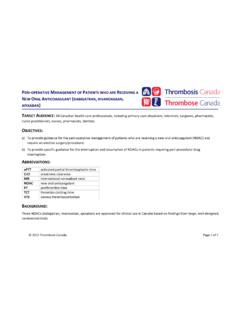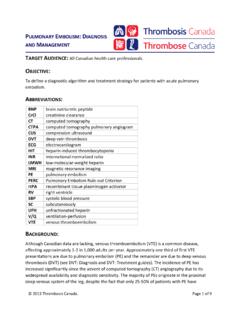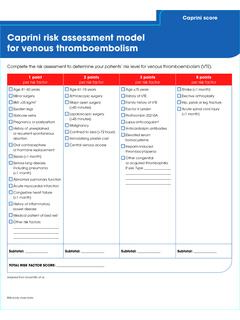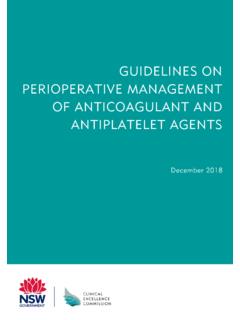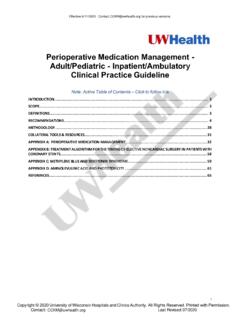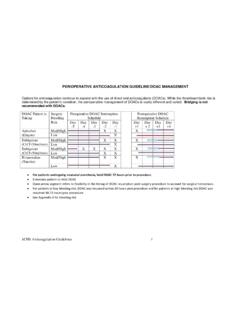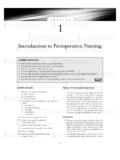Transcription of NOAC-DOACs Perioperative Management
1 *NOACs/DOACs = Non-vitamin K antagonist Oral AntiCoagulants, also known as Direct OralAnticoagulants known as Direct Oral AntiCoagulants NOACS/DOACS*: Perioperative Management OBJECTIVE: To provide guidance for the Perioperative Management of patients who are receiving a direct oral anticoagulant (DOAC) and require an elective surgery/procedure. For guidance on Management of patients who require an urgent or emergency surgery/procedure, please refer to the Perioperative Anticoagulant Management Algorithm found on the Thrombosis Canada website under the Tools tab. BACKGROUND: Four DOACs (apixaban, dabigatran, edoxaban and rivaroxaban) are approved for clinical use in Canada based on findings from large randomized trials.
2 The Perioperative Management of DOAC-treated patients aims to interrupt anticoagulant therapy (if necessary) so there is no (or minimal) residual anticoagulant effect at the time of surgery, and to ensure timely but careful resumption after surgery so as to not incur an increased risk for post-operative bleeding. There are 3 important considerations for Perioperative Management of patients taking a DOAC: 1) Reliable laboratory tests to confirm the absence of a residual anticoagulant effect of DOACs are not widely available. 2) Half-lives of DOACs differ and increase with worsening renal function, affecting when the drug should be stopped before surgery. 3) DOACs have rapid onset of action, with a peak anticoagulant effect occurring 1-2 hours after oral intake.
3 In the absence of laboratory tests to reliably measure their anticoagulant effect, the Perioperative administration of DOACs should be influenced by: 1) Drug elimination half-life (with normal renal function), 2) Effect of renal function on drug elimination half-life 3) Bleeding risk associated with the type of surgery/procedure and anesthesia (Table 1) 4) Whether patient is to receive spinal/epidural anesthesia EVIDENCE SUPPORTING Perioperative Management OF patients TAKING A DOAC: There are emerging data relating to the efficacy and safety of the proposed Perioperative Management of DOAC-treated patients . In RELY, a trial comparing dabigatran (150 mg or 110 mg) 2019 Thrombosis Canada Page 2 of 7 with warfarin for stroke prevention in atrial fibrillation, there were >4,500 patients who had anticoagulant interruption for a surgery/procedure.
4 The incidence of Perioperative bleeding was similar in dabigatran- and warfarin-treated patients , suggesting that dabigatran-treated patients can be safely managed perioperatively. Similar findings have been observed for the Perioperative Management of apixaban-treated, edoxaban-treated and rivaroxaban-treated patients . Perioperative Management : patients Receiving Dabigatran Pre-Operative Management (Table 2): Minor surgery/procedure (LOW BLEEDING RISK): In patients who require a minor dental procedure, cataract procedure, or minor skin procedure; it is likely safe not to interrupt anticoagulation (as is done in warfarin-treated patients ) but data to support such practice is lacking. An alternative approach would be to hold dabigatran on the day of the procedure or, if dabigatran is not interrupted, to delay that day s dose for 4-6 hours after the procedure.
5 MODERATE BLEEDING RISK Procedures: Stop dabigatran 1 day before surgery/procedure ( skip 2 doses before a surgery/procedure), which corresponds to approximately 2-3 half-lives elapsed between stopping dabigatran and surgery. There may be a 12-25% anticoagulant effect at the time of surgery, which is acceptable for these procedures. Major surgery/procedure including neuraxial anesthesia (HIGH BLEEDING RISK): Depending on renal function, stop dabigatran 2 or 4 days before surgery ( skip 4 or 8 doses), which corresponds to approximately 4-5 half-lives elapsed between stopping dabigatran and surgery. This ensures minimal (3-6%) residual anticoagulant effect at the time of surgery and allows patients to have spinal anesthesia or high bleeding risk surgery ( intracranial or cardiac).
6 If renal function is moderately impaired (CrCl 30-49 mL/min), 1-2 additional days of interruption is required to ensure elimination of any residual anticoagulant effect, as 80% of dabigatran is cleared by the kidneys. Post-Operative Management (Table 3): Resumption of dabigatran 150 mg or 110 mg twice daily should be done cautiously after major surgery or in patients at increased bleeding risk, as this is a therapeutic-dose which is higher than that used for post-operative VTE prevention. patients Receiving Rivaroxaban Pre-Operative Management (Table 2): Minor surgery/procedure (LOW BLEEDING RISK): In patients who require a minor dental procedure, cataract procedure, or minor skin procedure; it is likely safe not to interrupt anticoagulation (as is done in warfarin-treated patients ) but data to support such practice is lacking.
7 An alternative approach would be to hold rivaroxaban on the day of the procedure or, if rivaroxaban is not interrupted, to delay that day s dose for 4-6 hours after the procedure. 2019 Thrombosis Canada Page 3 of 7 MODERATE BLEEDING RISK procedure: Stop rivaroxaban 1 day before surgery/procedure ( skip 1 dose), which corresponds to approximately 2-3 half-lives elapsed between stopping rivaroxaban and surgery. Major surgery/procedure including neuraxial anesthesia (HIGH BLEEDING RISK): Stop rivaroxaban 2 days before surgery ( skip 2 doses), which corresponds to approximately 4-5 half-lives elapsed between stopping rivaroxaban and surgery. Post-Operative Management (Table 3): Resumption of rivaroxaban 20 mg (or 15 mg if usual dose) once daily should be done cautiously after major surgery or in patients at increased bleeding risk, as this is a therapeutic-dose which is higher than that used for post-operative VTE prevention.
8 patients Receiving Apixaban Pre-Operative Management (Table 2): Minor surgery/procedure (LOW BLEEDING RISK): In patients who require a minor dental procedure, cataract procedure, or minor skin procedure; it is likely safe not to interrupt anticoagulation (as is done in warfarin-treated patients ) but data to support such practice is lacking. An alternative approach would be to hold apixaban on the day of the procedure or, if apixaban is not interrupted, to delay that day s dose for 4-6 hours after the procedure. MODERATE BLEEDING RISK procedure: Stop apixaban 1 day before surgery/procedure ( skip 2 doses), which corresponds to approximately 2-3 half-lives elapsed between stopping apixaban and surgery.
9 Major surgery/procedure including neuraxial anesthesia (HIGH BLEEDING RISK): Stop apixaban 2 days before surgery ( skip 4 doses), which corresponds to approximately 4-5 half-lives elapsed between stopping apixaban and surgery. Post-Operative Management (Table 3): Resumption of apixaban 5 mg twice daily should be done cautiously after major surgery or in patients at increased bleeding risk, as this is a therapeutic-dose which is higher than that for post-operative VTE prevention. patients Receiving Edoxaban Pre-Operative Management (Table 2): Minor surgery/procedure (LOW BLEEDING RISK): In patients who require a minor dental procedure, cataract procedure, or minor skin procedure; it is likely safe not to interrupt anticoagulation (as is done in warfarin-treated patients ) but data to support such practice is lacking.
10 An alternative approach would be to hold edoxaban on the day of the procedure or, if edoxaban is not interrupted, to delay that day s dose for 4-6 hours after the procedure. MODERATE BLEEDING RISK procedure: Stop edoxaban 1 day before surgery/procedure ( skip 1 dose), which corresponds to approximately 2-3 half-lives elapsed between stopping edoxaban and surgery. 2019 Thrombosis Canada Page 4 of 7 Major surgery/procedure including neuraxial anesthesia (HIGH BLEEDING RISK): Stop edoxaban 2 days before surgery ( skip 2 doses), which corresponds to approximately 4-5 half-lives elapsed between stopping edoxaban and surgery. Post-Operative Management (Table 3): Resumption of edoxaban 60 mg or 30 mg daily should be done cautiously after major surgery or in patients at increased bleeding risk, as this is a therapeutic-dose.

